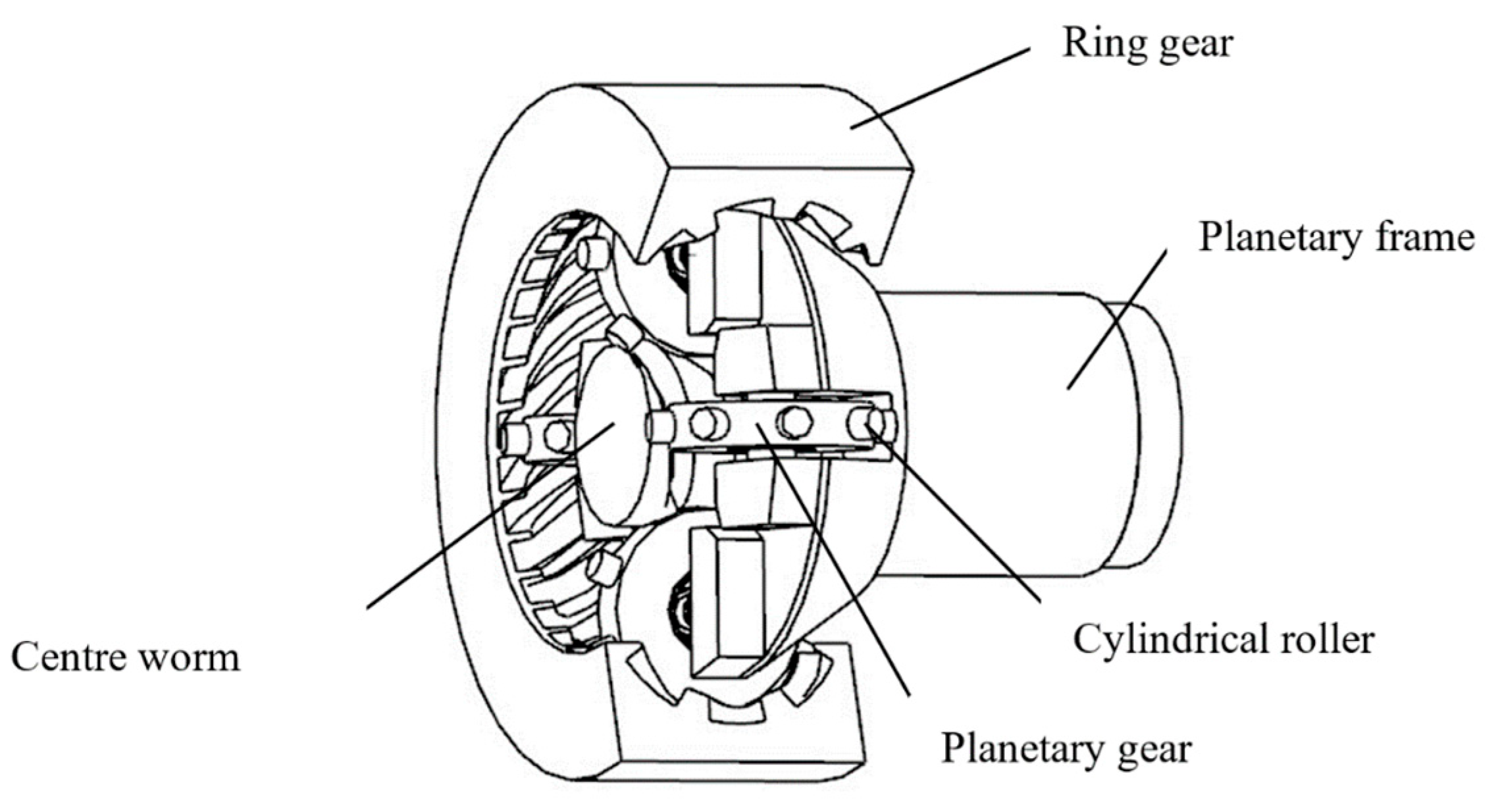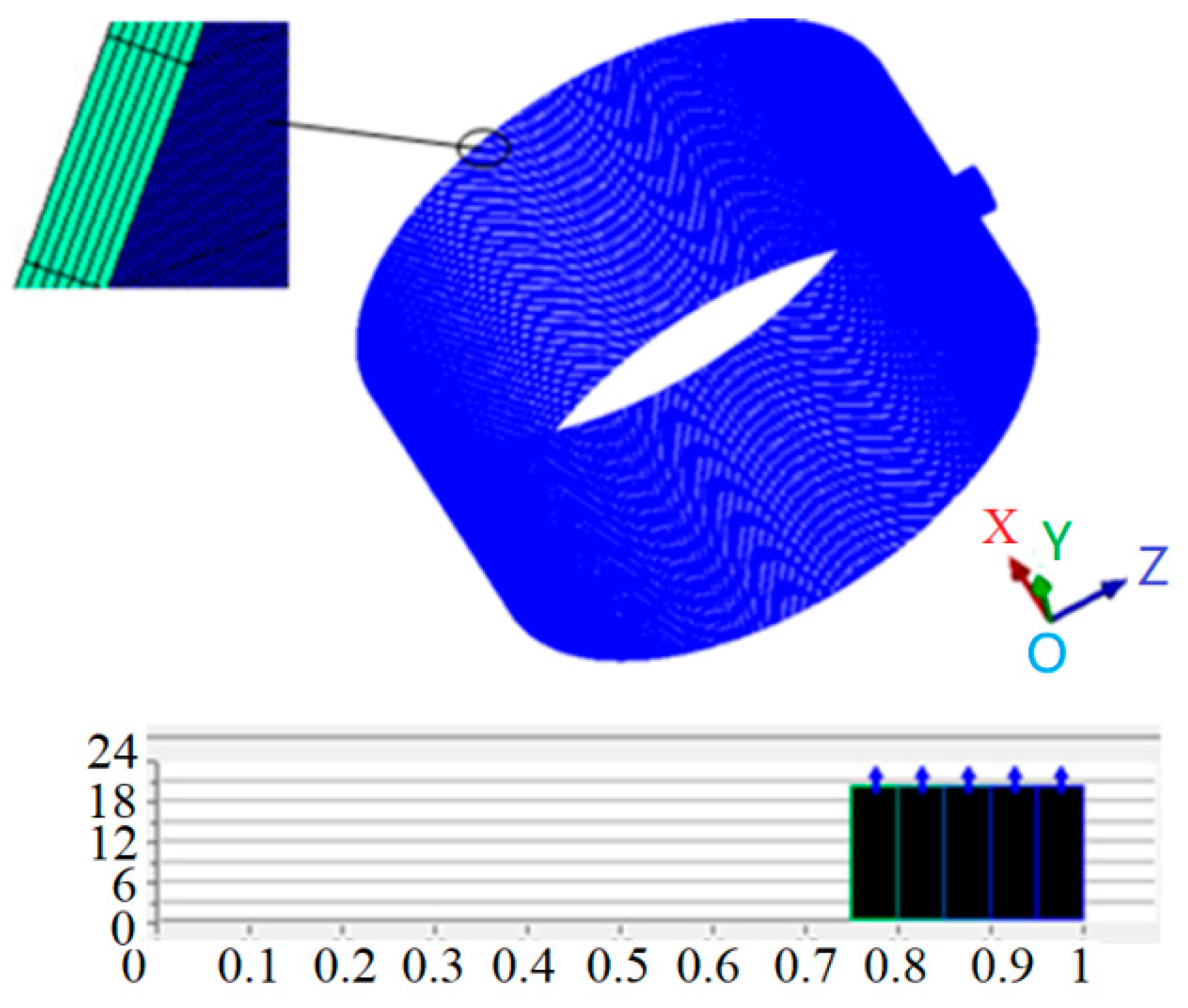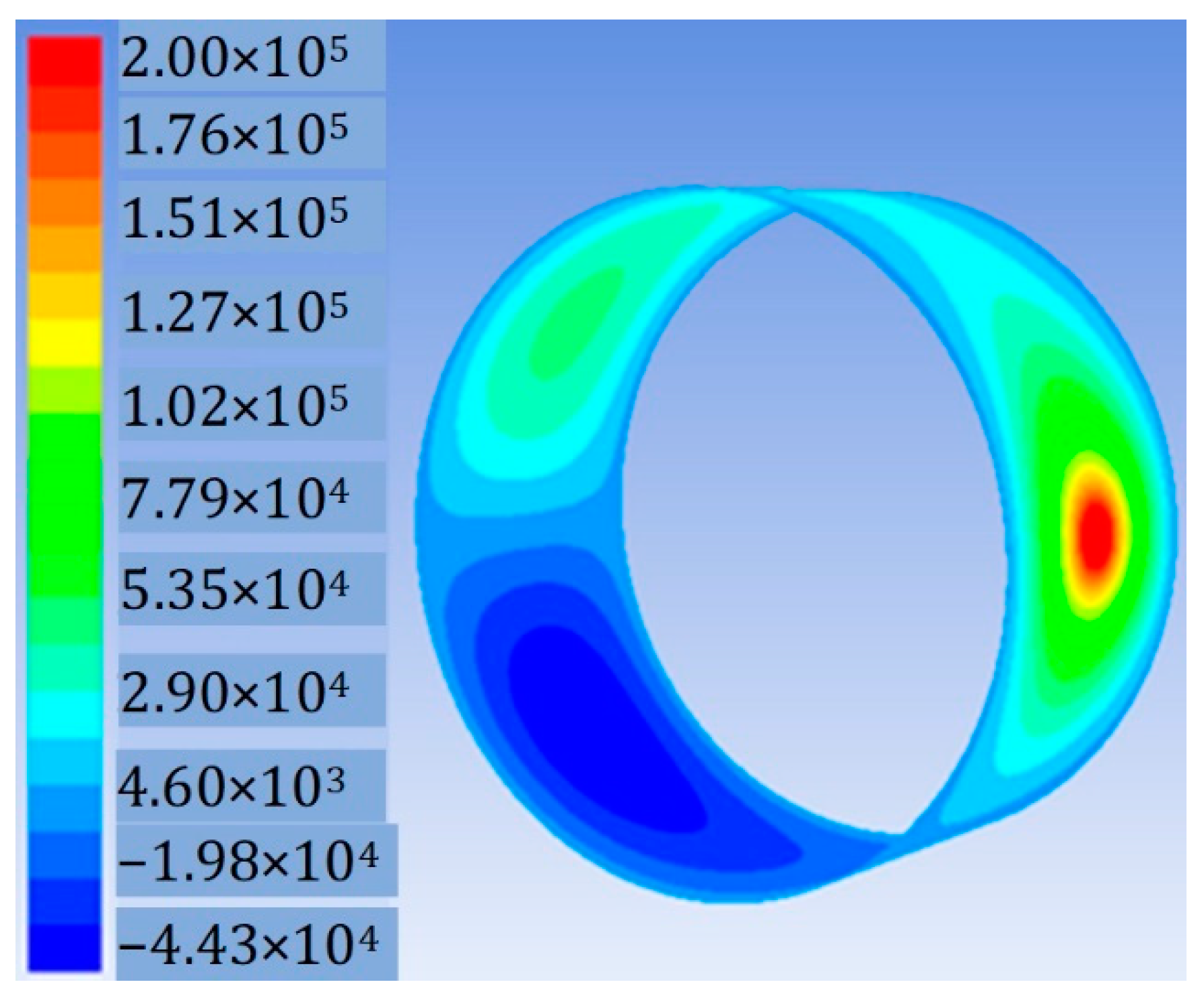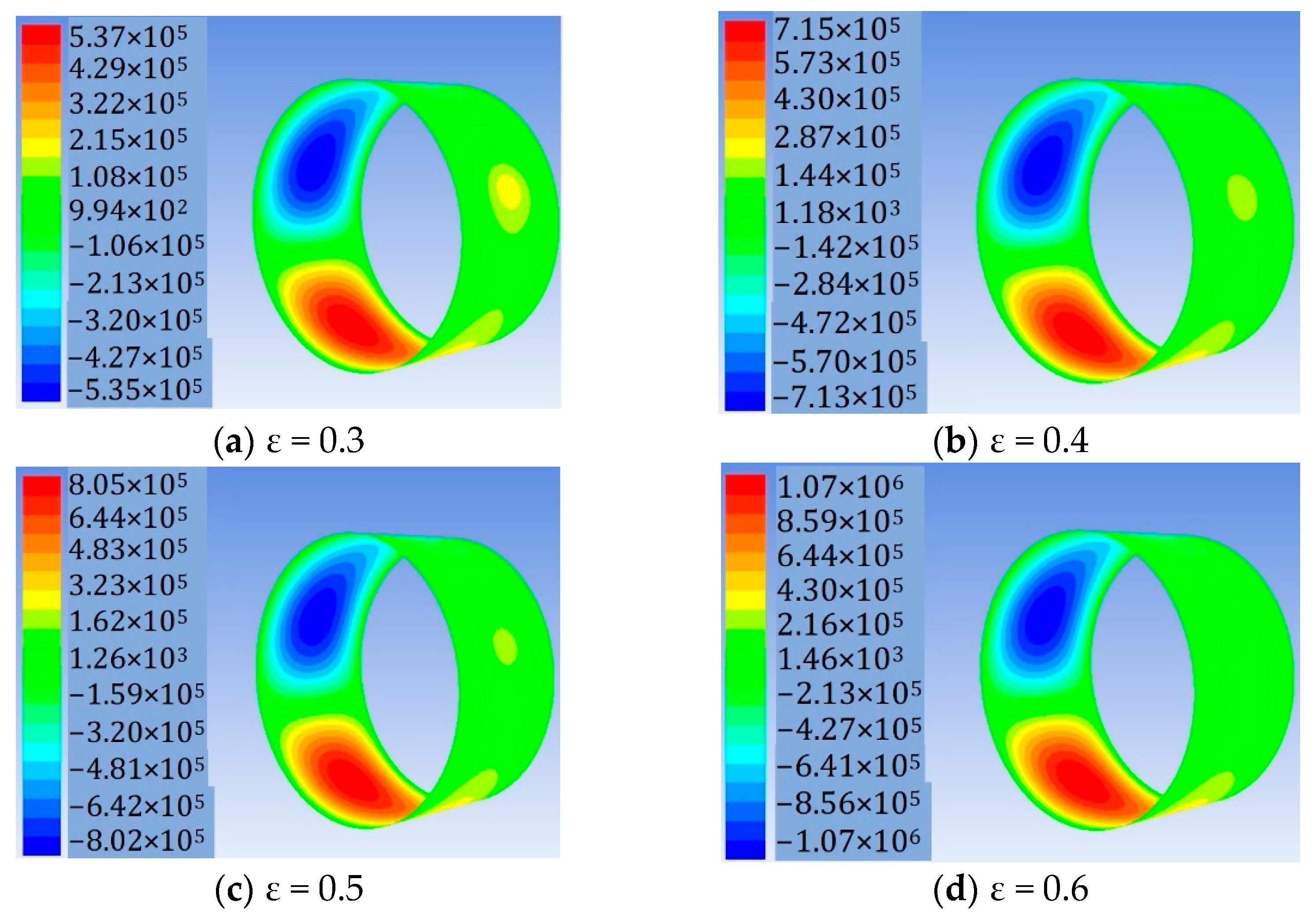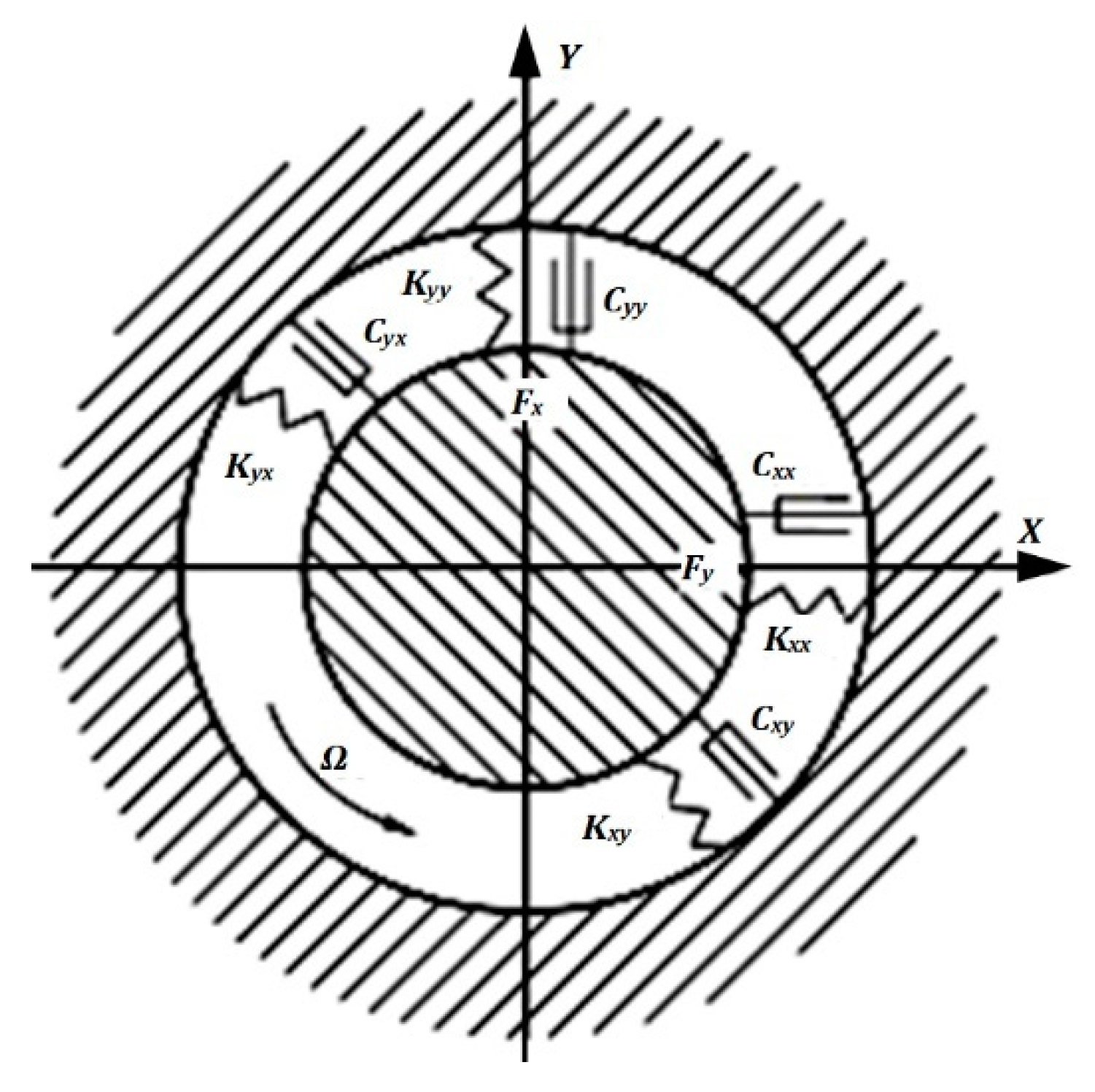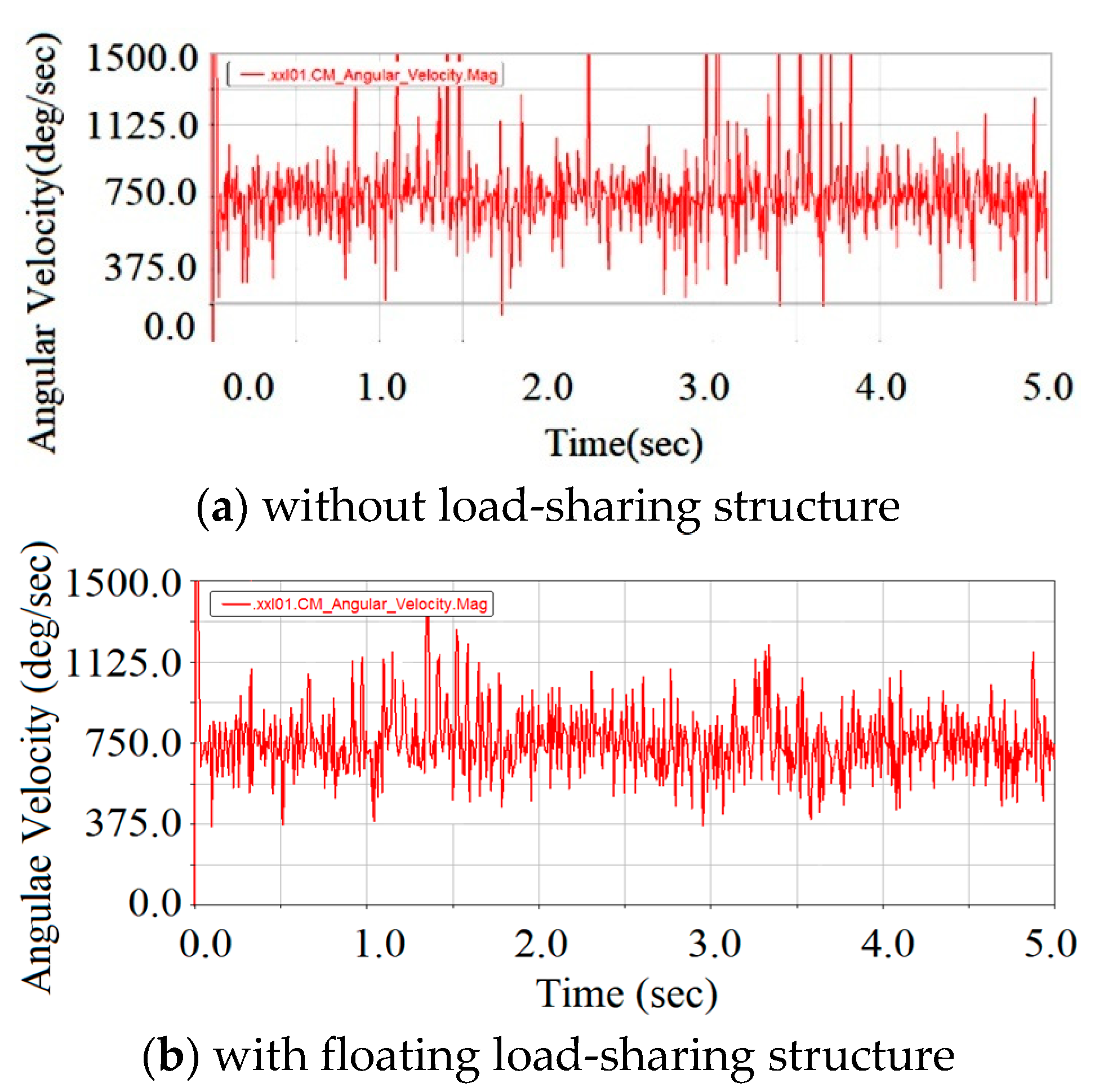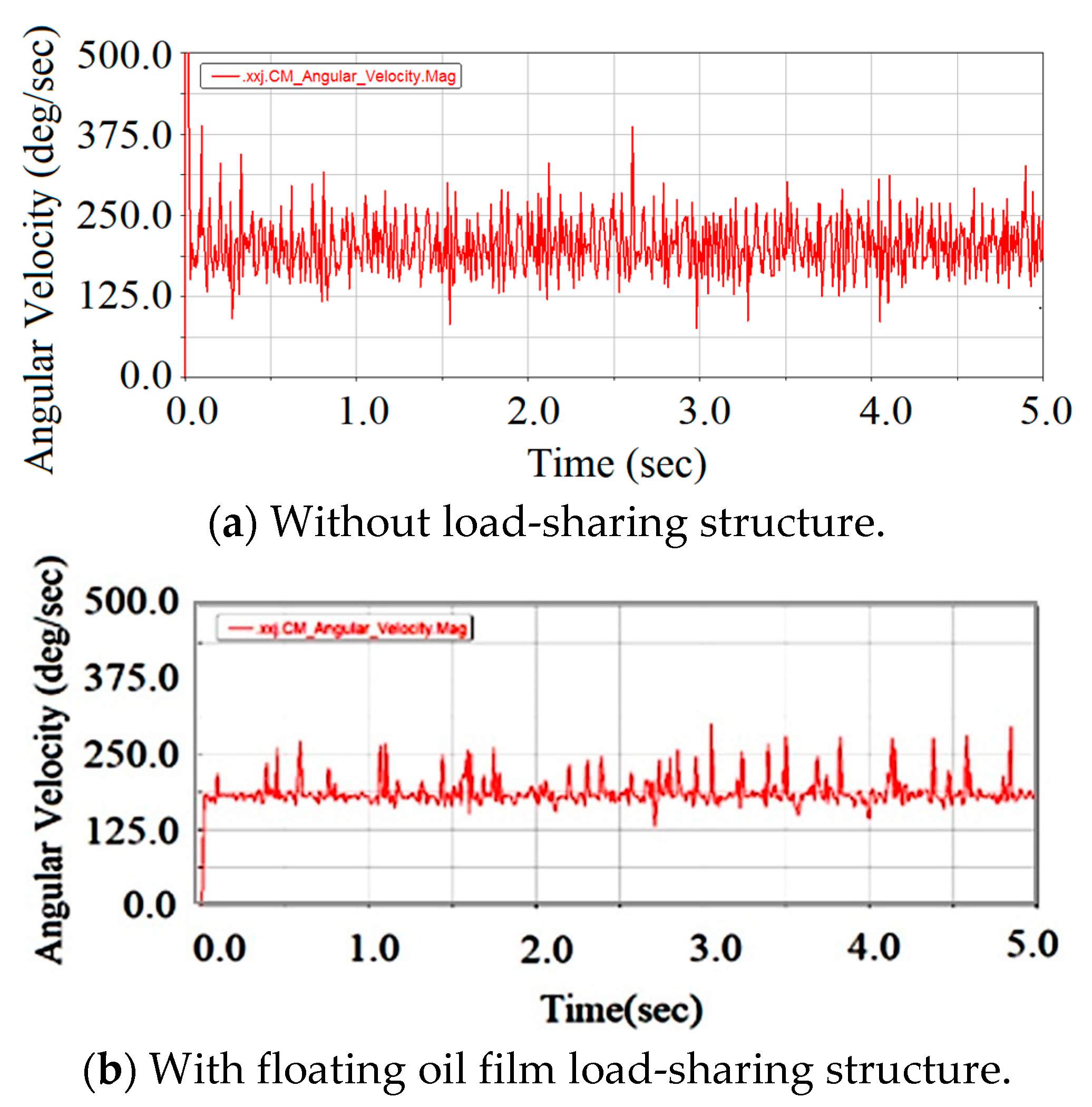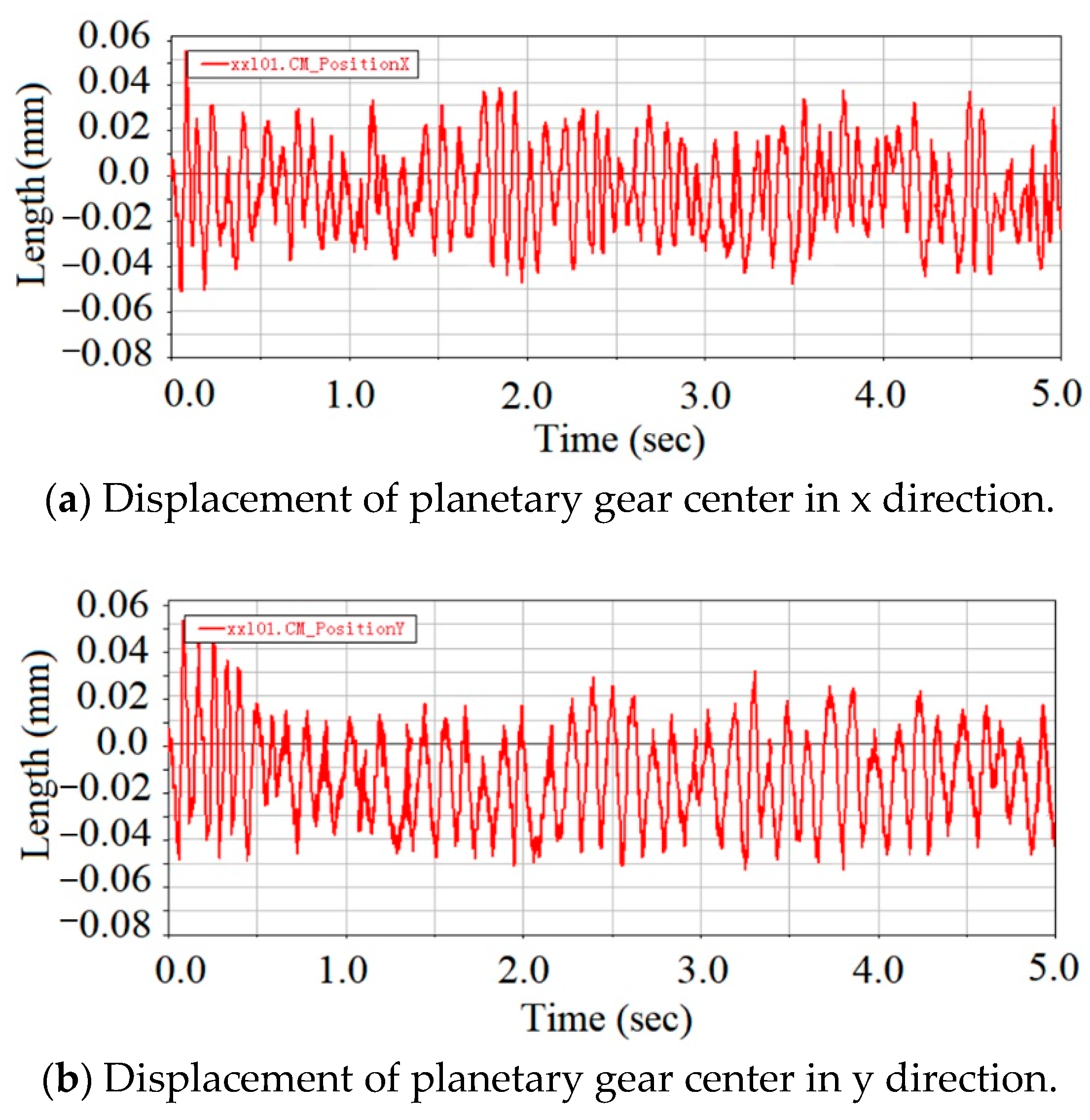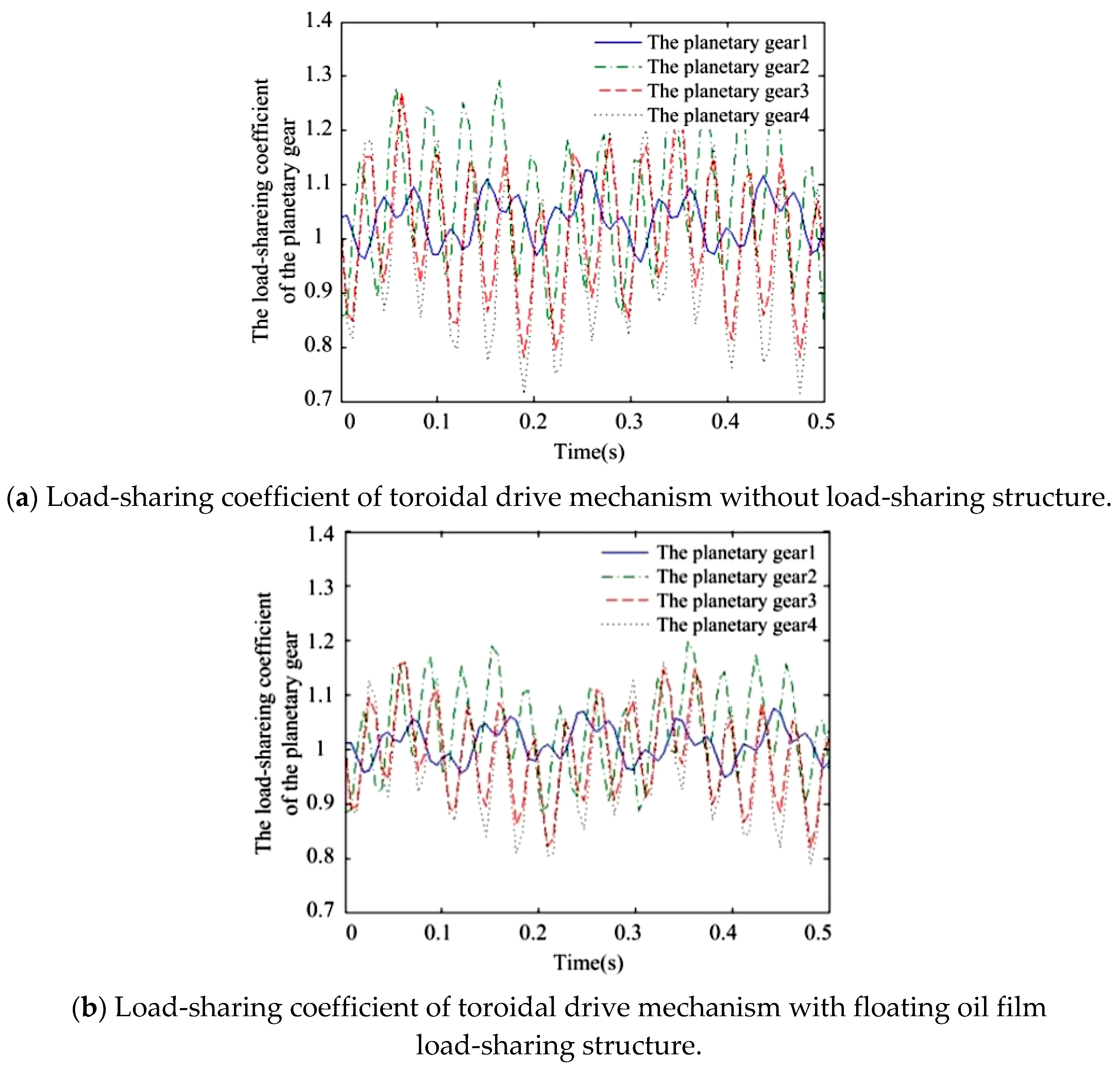1. Introduction
The toroidal drive mechanism has a number of planetary gears, a toroidal planetary worm (i.e., center worm), and a ring gear to transfer motion and power by meshing, so it has achieved a “power split”. In a toroidal planetary worm drive, the surface of the worm and worm wheel is a kind of space meshing surface, a ruled surface and is developable. This mechanism has the characteristics of a large bearing capacity, high transmission efficiency, large transmission ratio, and compact structure, and is a new type of transmission mechanism with good transmission performance [
1]. However, owing to the complicated transmission structure, the manufacturing of the center worm and ring gear is difficult, and errors in processing and assembly are therefore readily produced. These errors may lead to an unbalanced loading between the planetary gears, resulting in an eccentric load phenomenon and reductions in the transmission performance and service life of the mechanism [
2]. Therefore, the addition of an appropriate load-sharing structure can compensate for the influence of errors, solve the problem of uneven load distribution, and play a key role in excellent transmission performance of the toroidal drive mechanism.
In the field of toroidal load sharing, scholars have conducted in-depth theoretical and experimental research on toroidal drive load sharing, and have obtained significant research results [
3,
4,
5]. Boedo [
4] focused upon a practical design for big-end connecting rod journal bearings, which allow for rapid prediction of three key tribological performance measures: cyclic minimum film thickness, cyclic average oil flow and cyclic average power loss. Booker [
5] presented an approach for simplified analytical, graphical, and numerical solutions to extremely general problems of dynamically loaded bearings. Morris et al. [
6] presented the thermo-mixed-hydrodynamics of compression rings and big-end bearings. In addition, a floating oil film can probably influence the dynamic wear or surface interaction mechanisms between workpiece mating parts [
7,
8], such as floating surface mechanism of action [
9,
10], dynamic polished wear [
7,
11,
12] or surface treatment with some polishing methods [
13,
14,
15], etc. Thus, in order to improve load-sharing characteristics of the mechanism, a floating oil film load-sharing structure requires further analysis.
In this paper, in order to improve the load-sharing characteristics of the toroidal drive mechanism, a floating oil film structure system is designed to support the planetary gear and to compensate for inaccuracies. The hydrodynamic effect of the floating oil film is used to make the planetary gear shift, compensate for the influence of errors, and achieve the effect of load sharing. To verify the effect of the floating oil film structure, the floating oil film bearing is simulated using FLUENT, and the stiffness and damping coefficients of the floating oil film are calculated. In ADAMS, the method of equivalent replacement of the floating oil film with spring damping is adopted to conduct a dynamic analysis of the toroidal drive mechanism with the floating oil film load-sharing structure, and the effectiveness and feasibility of this structure are verified by comparing the changes in transmission performance of the system over time.
3. Numerical Simulation of Planetary Gear Floating Oil Film
3.1. Establishment and Meshing of Floating Oil Film Model
A three-dimensional (3D) model of the toroidal floating oil film bearing was established with a width to diameter ratio of 0.5, the inside of the floating oil film bearing was a fixed wall surface, the outside was a rotating wall surface, and the bearing had an oil inlet hole at the top. The basic parameters of the floating oil film bearing were as follows: diameter of bearing pad D = 48 mm, bearing width B = 24 mm, oil inlet diameter and height h1 = 0.5 mm, and eccentricity ε = 0.3.
The 3D model of the floating oil film bearing was imported into ANSYS ICEM modelling software using hexahedral mesh for the mesh division; the result is shown in
Figure 4. The value of the mesh determinant 2 × 2 × 2 was greater than 0.7 and the internal angle was greater than 18°, which led to a high partition quality and met the requirements of mesh quality [
21].
3.2. Steady-State Flow Field Calculation of Floating Oil Film
The steady-state flow field of the floating oil film was solved using FLUENT 14.0 software, the SIMPLE algorithm was used as the pressure–velocity coupling algorithm, Presto software was used to interpolate a discrete form of the pressure equation, and a second-order upwind method was used to interpolate a discrete form of the momentum equation [
22]. The initial rotation rate of the planetary gear was set to 1000 rpm, the eccentricity was 0.3, and the oil pressure was 0.2 MPa. The resulting pressure contours are shown in
Figure 5.
Based on the obtained pressure contours of the floating oil film, the following characteristics of the floating oil film can be obtained:
The floating oil film structure creates a stable oil pressure. The pressure is highest at the right-side inlet, with a value of 0.2 MPa. The pressures in the upper and lower oil chambers of the inlet gradually decrease, because when the floating oil film bearing operates, it moves down owing to gravity, which leads to a reduction in the oil film clearance of the lower oil chamber and an increase in that of the upper oil chamber. Positive and negative pressure regions are formed, which conform to hydrodynamic principles.
In the axial direction, because the floating oil film bearing discharges oil at both ends and these ends are at atmospheric pressure, the pressure of the oil film decreases in the axial direction and is at atmospheric pressure at the boundary.
In the circumferential direction, the oil film rotates in the same direction as the planetary gear, and the lubricating oil is throughout the entire clearance. When the lubricating oil moves from the oil inlet into the oil cavity, the pressure is at a maximum. With the rotation of the planet gear, the pressure of the oil film gradually decreases axially along the neck surface until the negative pressure zone is burst; the supply of lubricating oil then continues and a new pressure distribution of the oil film develops.
3.3. Force Field Characteristic Analysis of Floating Oil Film
The pressure and bearing capacity are the key characteristic parameters of the floating oil film and determine the resistance of the planetary gear to external load, that is, the effectiveness of the floating oil film load-sharing structure [
23]. The pressure and bearing capacity of the floating oil film are influenced by the design parameters, the working conditions, and many other factors, among which eccentricity is one of the most important; the eccentricity is therefore selected in this analysis as the main factor influencing the floating oil film. Owing to the eccentricity, the state of the floating oil film in each direction will change, producing new dynamic characteristics. However, an excessive eccentricity will produce strong hydrodynamic effects, and the lubricating oil in the clearances will be prone to backflow, which may cause the rupture of the oil film [
24]. Therefore, the influence of eccentricity between 0.3 and 0.6 was first studied, at a rotational speed of 2000 rpm and oil inlet pressure of 0.2 MPa. The pressure distribution of the oil film for different eccentricity s is shown in
Figure 6.
As shown in
Figure 6, the pressure of the oil film positive-pressure zone increases with the increasing eccentricity, but the pressure of the oil film negative-pressure zone decreases. This is because, with the increase in eccentricity, the oil film produces a larger wedge clearance, the positive-pressure oil chamber above the oil film increases gradually, the negative-pressure oil chamber under the oil film decreases gradually, the oil film is significantly squeezed, the hydrodynamic effect is more pronounced, and the pressure of the oil film increases.
As indicated in
Table 2, the bearing capacity of the oil film increases with increasing eccentricity. When the eccentricity increases, the wedge angle between the clearances then increases, the squeezing action of the oil film intensifies, and the maximum pressure of the oil film increases, such that the oil film can bear more load.
In the design of the floating oil film load-sharing structure, the eccentricity should therefore be increased appropriately, because that can improve the pressure and the bearing capacity of the floating oil film and enhance the resistance of the planetary gear to external loads. However, too large an eccentricity will cause oil backflow. The pressure and temperature of the oil film should also be controlled to avoid rupture of the oil film caused by excessive pressure and temperature.
3.4. Calculation of Equivalent Stiffness and Damping of Floating Oil Film
3.4.1. Difference Calculation Model of Stiffness and Damping
When the oil film bearing is disturbed by displacement or velocity in the static equilibrium position, the reaction force by the oil film on the shaft neck will change [
25]. When the disturbance is small and with a small amplitude, the relationship can be regarded as linear and the oil film can be regarded as having linearized stiffness and damping, as shown in
Figure 7.
Expanding the oil film force as a Taylor series and retaining the linear term, we obtain
The oil film force is approximated as a linear function of the minute displacement and velocity of the shaft neck. In Equation (7), the subscript 0 indicates that the derivative is taken at the static equilibrium position. The oil film force increment caused by the disturbance displacement is defined as the stiffness coefficient of the oil film, that is,
The oil film force increment caused by the speed displacement is defined as the damping coefficient of the oil film, that is,
In the formulae, the first subscript represents the direction of the force, and the second represents the direction of the displacement or velocity. Thus, the dynamic characteristics of the oil film depend directly on the disturbance pressure.
3.4.2. Calculation of Stiffness and Damping of Floating Oil Film
A disturbance velocity of v = 25 μm/s and disturbance displacement of s = 25 μm was applied to the floating oil film bearing, the planetary gear rotational speed was set to 1000 rpm, and the oil inlet pressure was set to 0.2 MPa. The oil film force before and after the disturbance was calculated by FLUENT post-processing, and the stiffness and damping coefficients of the oil film were calculated by substituting the oil film force into Equations (8) and (9). The coefficients are listed in
Table 3.
